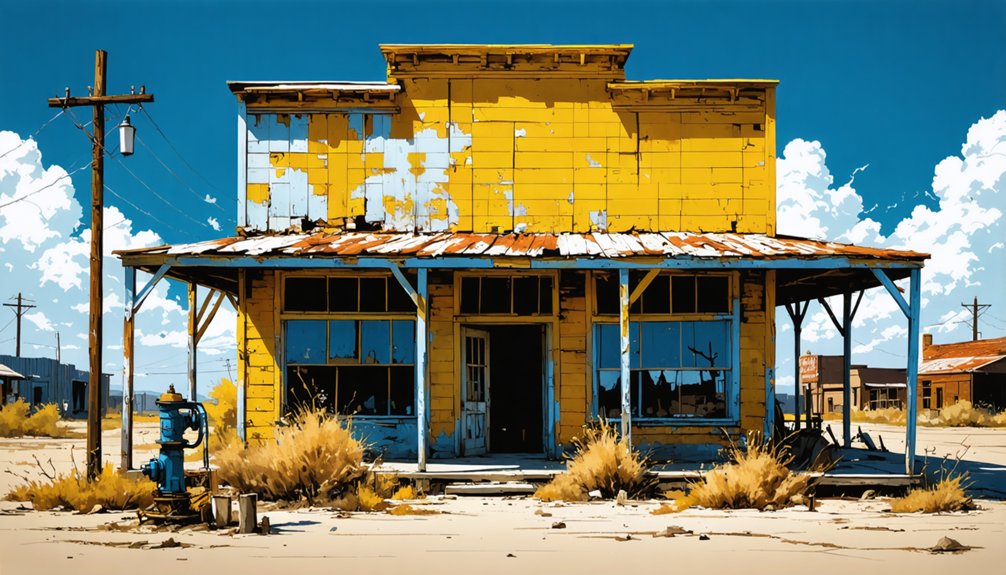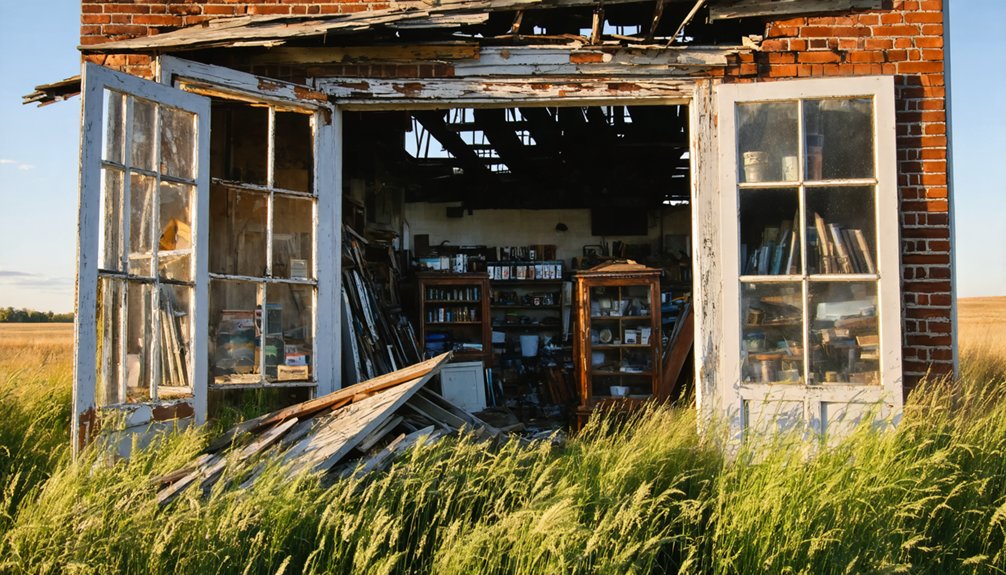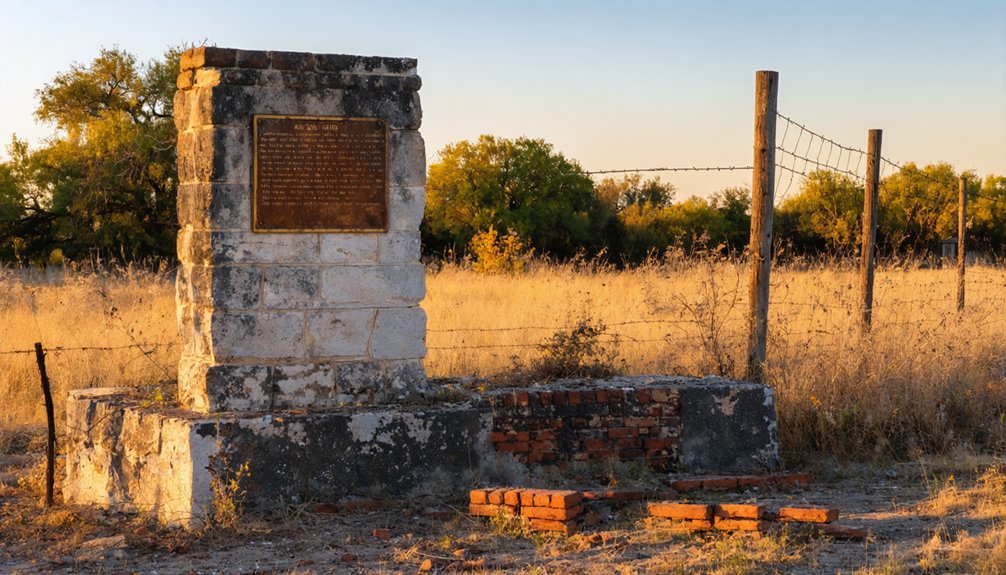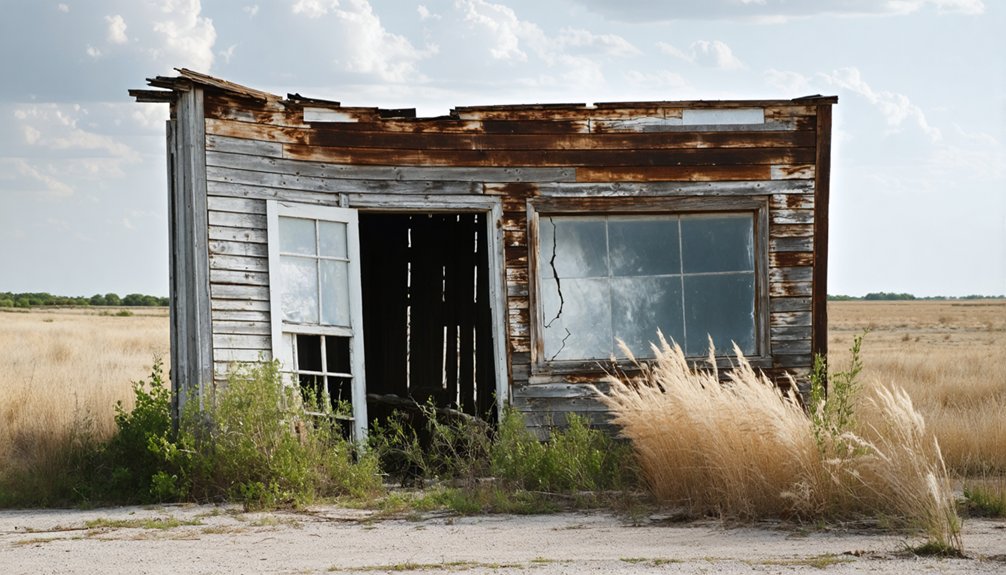You’ll find Zella’s remains along the San Antonio, Uvalde & Gulf Railroad, where ambitious founders established this Texas ghost town in 1913. Named after Howard Bland’s daughter, the town featured 189 planned blocks, a railroad depot, hotel, and schoolhouse. Despite high hopes, severe drought and World War I’s economic pressures led to its rapid decline by 1917. Only scattered rubble and foundation traces remain today, though historic maps reveal the full scope of this failed railroad settlement.
Key Takeaways
- Zella was established in 1913 as a railroad town along the San Antonio, Uvalde & Gulf Railroad with ambitious plans for 189 city blocks.
- The town was named after Howard Bland’s daughter and centered around a railroad depot that served as a cattle shipping hub until 1959.
- Despite infrastructure investments including a hotel, school, and store-post office, severe drought and World War I challenges limited growth.
- The community existed briefly from 1912 to 1917, with fewer than 200 residents before drought forced mass exodus.
- Today, only scattered rubble and foundations remain, with the two-story hotel standing as the most prominent remnant of the failed town.
The Birth of a Railroad Town (1913)
Three ambitious entrepreneurs – C. A. Nelson, Howard Bland, and R. B. Pumphrey – launched their vision for a railroad town in 1913 by forming the Zella Townsite Company.
They’d strategically chosen a location along the San Antonio, Uvalde & Gulf Railroad, mapping out 189 city blocks for what they hoped would become a thriving community. The railroad impact was immediate, as they constructed essential facilities including a depot, hotel, schoolhouse, and a combination store-post office.
Named after Howard Bland’s daughter Zella, the town’s founders drilled a water well and distributed promotional brochures to attract settlers. Similar to other disambiguation pages, multiple towns across Texas shared the Zella name during this period. The founders maintained ownership of lots throughout the town’s existence, which ultimately affected its potential for expansion.
The hopeful founders named their town Zella, drilled for water, and spread the word to potential settlers through brochures.
Despite their careful planning and initial development, settlement challenges emerged quickly. The outbreak of World War I and a devastating drought in 1917 hindered their dreams of creating a bustling railroad hub.
Early Development and Infrastructure
The Zella Townsite Company’s development of the community began with essential infrastructure, including the construction of a railroad depot to serve as a significant shipping hub along the San Antonio, Uvalde and Gulf Railroad.
You’ll find that early town planning centered on the establishment of a hotel and several homes, while a well was dug to provide water for the settlement’s anticipated growth. Following a pattern seen in many Texas ghost towns, the settlement’s ambitious beginnings held promise for growth and prosperity.
The initial layout and construction efforts demonstrated the developers’ vision for a sustainable railroad town, though their plans for irrigation infrastructure would ultimately go unfulfilled. Much like the town of Independence, the community’s fate was tied to its relationship with the railroad lines and transportation networks.
Railroad Station Hub
During Zella’s establishment in 1913, a pivotal San Antonio, Uvalde & Gulf Railroad depot emerged as one of its first and most essential structures. As the town’s primary transportation hub, you’d find the depot facilitating cattle shipments that continued until 1959, even as other aspects of the town declined. Much like the Cotton Belt Railroad towns of Bailey and Randolph, Zella was born from railroad expansion.
The Zella Townsite Company constructed key infrastructure to support the depot’s economic viability, including a drilled water well, store-post office, and hotel for travelers. Similar to the first through train that ran from Houston to Orange in 1876, this depot represented a significant milestone in Texas railroad development.
You can trace the founders’ vision through their strategic marketing efforts, as C. A. Nelson, Howard Bland, and R. B. Pumphrey distributed brochures promoting the railroad-accessible settlement.
Despite these efforts, external challenges like World War I and the 1917 drought severely limited the depot’s potential to transform Zella into a thriving rail center.
Initial Town Layout
Founded in 1913 by the Zella Townsite Company, this railroad settlement emerged along the San Antonio, Uvalde & Gulf Railroad with a carefully planned infrastructure designed to attract settlers and commerce.
The town layout centered around key transportation nodes, with a rail depot serving as the hub of economic activity. You’ll find the original infrastructure design included a hotel for visitors and cattle drovers, plus a central well to provide water for the community. Like many rural Texas towns of today that struggle with water supply issues, maintaining reliable water infrastructure proved to be an ongoing challenge.
The company distributed promotional brochures to draw settlers, while a post office was established in 1914 to serve the growing population. Residential areas developed near the railroad, with simple homes built to accommodate new residents.
While the initial planning was ambitious, the town’s infrastructure ultimately fell short of promised developments, particularly regarding irrigation facilities.
Community Building Construction
As Zella emerged along the railroad line, initial construction efforts by the Zella Townsite Company focused on essential community buildings to attract settlers and commerce.
You’ll find they prioritized key community infrastructure including a rail depot with loading platforms, a hotel for travelers, and a post office established in 1914.
Like many towns of that era, Zella’s fate was tied to single industry dependence as its economic foundation.
The rail depot served as the town’s lifeline, facilitating cattle shipments and passenger movement until 1959. They built a well to provide water for residents and livestock, though the promised irrigation systems never materialized.
The hotel doubled as a social hub and lodging for railway passengers, later adapting to serve deer hunters. While these settlement strategies showed initial promise, inadequate water infrastructure and economic challenges led to the post office’s closure by 1916, signaling the town’s decline.
Land Promotion and Settlement Dreams
You’ll find that Zella’s founders pinned their hopes on the San Antonio, Uvalde & Gulf Railroad, laying out 189 city blocks with visions of a thriving agricultural community.
The founders’ promotional efforts centered on land sales and the promise of essential infrastructure, including a depot, store-post office, schoolhouse, and hotel. Texas history shows that communities like Zella were among the 511 ghost towns scattered across the state. Like Thurber’s eventual decline due to the transition to oil, many railroad towns faced similar fates.
Despite these ambitious plans and early optimism, the venture failed to gain traction as few lots sold, leaving most of the land in the original founders’ possession.
Railroad Dreams Derailed
The ambitious Zella Townsite Company launched their dream settlement in 1913 with grand plans for a 189-block city alongside the San Antonio, Uvalde & Gulf Railroad.
You’d have seen initial railroad expectations soar as they built a depot, store-post office, hotel, and water well to attract settlers to their vision of a thriving trade hub.
But settlement challenges quickly mounted. The railroad’s promise of connecting rural areas to larger markets fell short when irrigation plans stalled. A devastating drought in 1917 and World War I’s resource drain dealt further blows.
While cattle drovers used Zella as a shipping point until 1959, the railroad’s broader regional struggles, including poor profitability and difficult terrain, ultimately derailed dreams of sustainable growth.
Failed Promises of Prosperity
While grand visions of prosperity drove the Zella Townsite Company’s 1913 development plans, their ambitious 189-block city layout would never materialize beyond initial foundations.
You’ll find evidence of failed investments throughout Zella’s brief history – from the short-lived post office that closed by 1916 to the underutilized hotel and schoolhouse that couldn’t sustain a stable population.
Community aspirations were crushed by a perfect storm of setbacks: World War I’s economic disruptions stifled growth, while a devastating 1917 drought destroyed agricultural prospects.
Despite promising railway access and fertile land claims, most plots remained unsold in the founders’ hands.
Like many Texas ghost towns of the era, Zella stands as a reflection of unfulfilled dreams of railroad-driven prosperity and land speculation gone wrong.
Life in Early Zella

During its formative years, early Zella emerged as a tight-knit farming community with fewer than 200 residents, primarily consisting of European immigrants drawn to the region’s agricultural opportunities.
You’d find strong community bonds forged through shared agricultural practices, seasonal work routines, and social gatherings at the local church and schoolhouse. Life centered around essential establishments where you could trade goods, share stories, and support one another through challenging times.
- Wood-frame homes and log cabins dotted the landscape, built from local timber
- A one-room schoolhouse served as both educational center and community hub
- The Protestant church provided spiritual guidance and social connection
- Bartering systems helped overcome limited access to cash and banking
- Community work events, like barn-raisings, strengthened neighbor relationships
The Short-Lived Economic Boom
As Zella emerged along the San Antonio, Uvalde and Gulf Railroad in 1913, you’d find a carefully orchestrated economic development plan unfolding through the Zella Townsite Company‘s strategic investments.
They built essential infrastructure including a hotel, rail depot, and well while circulating brochures to attract settlers.
Despite initial economic optimism fueled by the railroad’s presence and cattle shipping operations, Zella’s prosperity proved short-lived.
The devastating combination of irrigation failures and persistent drought conditions quickly undermined the town’s agricultural foundation.
While you could still find cattle drovers utilizing the rail facilities until 1959, the promised irrigation systems never materialized.
Signs of Decline and Exodus

Once the promotional promises of the Zella Townsite Company began to crumble, signs of decline emerged swiftly and decisively. The severe drought of 1912-1917 dealt a crushing blow to agricultural dreams, triggering rapid population decline. Without sufficient capital for irrigation, farming became impossible, and you’d have witnessed a mass community abandonment within just five years of the town’s founding.
- The post office and general store closed as residents fled
- The grand hotel lost its original purpose, becoming seasonal hunting quarters
- The ambitious 189-block layout turned into overgrown wilderness
- Essential infrastructure projects remained incomplete
- Water scarcity made agricultural ventures collapse completely
The exodus was unstoppable – a stark reminder that even the most promising frontier developments couldn’t survive without sustainable resources and proper planning.
Legacy of a Failed Settlement
Today, Zella’s legacy stands as a stark warning about the perils of speculative land development in early 20th-century Texas.
When you look at the town’s remains, you’ll find the two-story hotel as the most prominent reminder of those ambitious speculative investments that went wrong. The structure, now serving as seasonal quarters for hunters, symbolizes how quickly agricultural failures can doom a settlement’s future.
You can still find Zella about 8 miles north of Fowlerton on Texas Highway 97, though it’s on private property with limited access.
The town’s brief five-year existence, from its hopeful founding in 1912 to its collapse during the 1917 drought, demonstrates how insufficient planning and environmental challenges can swiftly destroy even the grandest development schemes.
Modern Day Remnants and Historical Markers

Very little remains of Zella’s physical presence in modern McMullen County, with only scattered rubble and difficult-to-find foundations marking where the settlement once stood.
While there aren’t any dedicated historical markers at the site, nine preserved historic maps guide modern remnants exploration. These maps help metal detecting enthusiasts locate potential artifacts and understand the town’s original layout, offering a window into its brief existence.
- No standing structures remain at the abandoned townsite
- Historic maps detail old homesites and trails for exploration
- Nearest historical markers are in Tilden, focusing on broader regional history
- Metal detecting enthusiasts use preserved maps to locate buried artifacts
- The site’s historical significance is documented through maps rather than markers
Frequently Asked Questions
What Was the Original Purchase Price of Land Plots in Zella?
You won’t find exact historical pricing records for land acquisition in Zella, but based on comparable ghost towns, you’d likely have paid just a few dollars to low hundreds per plot.
Were There Any Notable Crimes or Lawless Incidents in Zella?
Ever wonder what secrets small Texas towns held? You won’t find documented crime history or law enforcement records for this settlement – historical records show no notable lawless incidents or criminal activity.
What Natural Disasters or Weather Events Affected Zella During Its Existence?
You won’t find records of major flooding events in Zella’s history, but severe drought conditions from 1917 onward devastated the community’s farming potential, ultimately contributing to its rapid downfall.
Which Families Were the Last to Leave Zella?
You’d think someone would’ve kept track of Zella’s last families, but historical records don’t name any specific last residents besides the founding Bland family before the town’s gradual abandonment by 1916.
Did Any Indigenous Peoples Have Settlements in the Zella Area Before 1913?
You’ll find indigenous history shows Coahuiltecan bands used the area for seasonal camps rather than permanent settlements, following nomadic settlement patterns as they hunted and gathered across South Texas’s brushlands.
References
- https://www.county.org/county-magazine-articles/summer-2025/ghost-towns
- https://roadsidethoughts.com/tx/zella-xx-mcmullen-profile.htm
- https://en.wikipedia.org/wiki/List_of_ghost_towns_in_Texas
- https://www.tshaonline.org/handbook/entries/zella-tx
- https://www.ghosttowns.com/states/tx/zella.html
- http://www.stxmaps.com/go/texas-historical-marker-townsite-of-zella.html
- https://www.texasescapes.com/TOWNS/Texas-Ghost-Towns-8-South-Texas.htm
- https://www.texasescapes.com/SouthTexasTowns/Zella-Texas.htm
- https://texashistory.unt.edu/ark:/67531/metapth1740471/m1/4/?q=”~1~1″~1
- https://en.wikipedia.org/wiki/Zella



